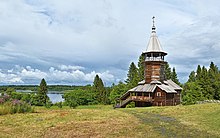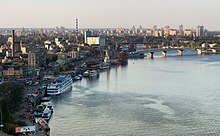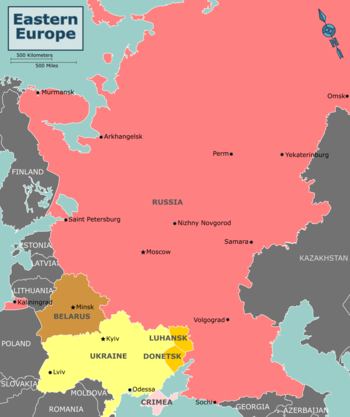| WARNING: Due to the Russian invasion of Ukraine and civil unrest, many governments advise against travelling to Ukraine, Belarus, Russia, and the disputed territories in the region. See also war zone safety. | |
| (Information last updated 10 Dec 2023) |
The term Eastern Europe can defined in several different ways; see the understand section below for discussion. This article uses a fairly narrow definition, covering only Belarus, Russia and Ukraine.
Countries and territories
[edit]| Belarus Sometimes called "Europe's last dictatorship", Belarus is the largest remaining Soviet-style country in the world. |
| Russia The world's largest country, stretching from the Baltic Sea to the Pacific Ocean. |
| Ukraine Europe's most fertile soil, with mighty rivers. |
| Crimea A peninsula in the Black Sea, part of Ukraine until 2014 and still claimed by them, but since then a de facto part of Russia. |
| Donbas (Donetsk Oblast, Luhansk Oblast) Regions in eastern Ukraine, partly controlled by Russian-backed separatists from 2014 until the Russian invasion of 2022. More or less a war zone as of 2023. |
|
Nominal and de facto political status of the disputed territories in Eastern Europe are controversial. This article intends to describe the practical situation for visitors, and is not an endorsement of any point of view in the conflict. |
Although part of Kazakhstan is west of the Ural River and thus in Europe, the country is mainly in Central Asia and covered as part of that region.
For the south-easternmost part of Europe, see Caucasus.
Cities
[edit]
- 1 Kazan — the capital of Tatar culture is an attractive city in the heart of the Volga Region with an impressive kremlin
- 2 Kyiv (Kiev) — Ukraine's capital with heritage from the Viking Age
- 3 Minsk — capital of Belarus
- 4 Moscow — the heart and brain of the largest country on Earth, Moscow has the heritage of both the tsars and the Soviets and all the other current or former occupants of the Kremlin
- 5 Odesa — a harbour city on the Black Sea with a mixture of different cultures.
- 6 Saint Petersburg — Russia's gateway to the West
- 7 Sevastopol — a port city on the Crimea
- 8 Sochi — a city on the Black Sea which hosted the 2014 Winter Olympics
- 9 Volgograd — formerly called Stalingrad, this city was the scene of perhaps the deciding battle of World War II, and now home to a massive war memorial
Other destinations
[edit]
- 1 Border of Europe and Asia — it's clearly defined near Yekaterinburg, and a very popular stop for photo ops straddling the continents!
- 2 Golden Ring — a loop of pretty historical cities and towns forming a ring northeast of Moscow
- 3 Kizhi — one of the most precious sites in all Russia, Kizhi Island on Lake Onega is famous for its spectacular ensemble of traditional wooden churches, a
 UNESCO World Heritage Site.
UNESCO World Heritage Site. - 4 Komi Virgin Forests — profoundly remote, and hard-to-visit, but this is by far Europe's largest wild area, containing Europe's largest National Park, Yugyd Va
- 5 Pushkinskiye Gory — the estate and museum of Alexander Pushkin, a world-known Russian poet.
- 6 Chernobyl — tour the site of the infamous 1986 nuclear disaster
- 7 Wooden tserkvas of the Carpathian region — Orthodox churches,
 UNESCO World Heritage Site
UNESCO World Heritage Site - 8 Belovezhskaya Pushcha National Park — on the border between Belarus and Poland, this primeval forest is a
 UNESCO World Heritage Site
UNESCO World Heritage Site - 9 Uman — city in central Ukraine with the famous Sofiyivka Park
Understand
[edit]
This article covers Belarus, Russia and Ukraine, all of which use East Slavic languages and share a common heritage going back to the Russian Empire and the Soviet Union, with Orthodox Christianity as the dominant religion. Parts of Western Ukraine, including the city of Lviv, have a Catholic majority, albeit one that celebrates its liturgy according to the Eastern rite.
During the Cold War a different definition of "Eastern Europe" was used, at least in the Western press and history textbooks. It included all the Communist countries of Europe which were members of the Warsaw Pact alliance, excluding the Soviet Union. In Churchill's phrase, these were the countries behind the "Iron Curtain".
Countries that were included in that definition but are treated in other region articles here are:
- In the Balkans
- In Central Europe
- Poland, the Czech Republic and Slovakia, with West Slavic languages and largely Roman Catholic
- Hungary
- The former East Germany, now part of the reunited Germany
Some countries in Europe were lumped in with Eastern Europe by some because they were Communist, although they were not part of the Warsaw Pact and neither geographically nor linguistically East European. These were:
- Yugoslavia — now Serbia, Croatia, Slovenia, Bosnia and Herzegovina, Montenegro, North Macedonia and Kosovo
- Albania (was in the pact, but withdrew from it in the 1960s)
A broader definition could include the following former Soviet republics and areas:
- Russia, Belarus and Ukraine, which we cover here
- Moldova and the not-widely-recognised breakaway country of Transnistria
- The Baltic states: Lithuania, Latvia and Estonia
- In the Caucasus, in addition to the Russian North Caucasus:
- Georgia, Armenia and Azerbaijan
- Abkhazia and South Ossetia, which are secessionist states, not widely recognised by other countries
History
[edit]
Since ancient times, nomadic peoples have travelled across the Eastern European plains, forests and tundras. The Rus were a tribe of partially Scandinavian origin (see Vikings and the Old Norse) which settled along the rivers of eastern Europe from the 9th century and onwards, and over time became assimilated by the local Slavic population, with their name surviving in the names of Russia and Belarus. In the 13th century, the Mongol Empire conquered the Eurasian plains and vassalised many Slavic nations under the Golden Horde. The Russians eventually defeated the Mongols, and in 1547 Ivan IV proclaimed himself Czar of Russia, a country which was to expand south to the Caspian Sea, and east to the Pacific Ocean. Most of today's Belarus and Ukraine were part of the Polish-Lithuanian commonwealth.
In 1721, Peter the Great defeated the Swedish Empire in the Great Northern War, and proclaimed himself to be Emperor of the Russian Empire, which became one of Europe's and the world's great powers.
The Russian Empire was drawn into World War I, which led to the Russian Revolutions (February and October). The Soviet Union was the product of the October Revolution, and after it consolidated control over Russia, it was able to take over the other states defined as Eastern Europe in this article. The Soviet Union was hit hard by World War II in Europe, and was one of the adversaries of Cold War Europe until dissolved in 1991, with Russia, Belarus and Ukraine becoming sovereign countries. The Soviet power structure still remains in the region, as Russia keeps Belarus as a close ally, and makes claims on Ukraine.
Talk
[edit]Russian, Belarusian and Ukrainian are the East Slavic languages, together with the Rusyn language, which is spoken locally in the Carpathians. The East Slavic languages are written with Cyrillic script and are to some degree intelligible to each other. Ukrainian and Belarusian are mutually intelligible to a large extent, while Russian significantly more challenging for those who only speak Ukrainian or Belarusian and vice versa. Russian was the common language for inter-ethnic communication in the Soviet Union and is commonly used in Belarus, as well as in eastern and southern Ukraine.
30 million people in Russia have a mother language other than Russian; see Minority cultures of Russia. In Western Ukraine, there are also minority communities who speak Polish, Romanian or Hungarian as their mother tongues.
English was not commonly taught during the Soviet era but can be understood by educated young people.
Get in
[edit]By plane
[edit]By train
[edit]The Trans-Siberian Railway from Beijing and Vladivostok to Moscow is a classic rail journey. The Almaty–Urumqi service runs twice per week, and Moscow is easily reached from Almaty by train.
Get around
[edit]- See also: Driving in Russia, Marshrutka
Due to the war, transportation between Ukraine and Russia is shut down.
See
[edit]- See also: Eurasian wildlife
The Russian Empire was a patron of European art and European classical music, in particular in Saint Petersburg and Moscow. The autonomous republics are known for their local folk culture, see minority cultures of Russia.
Do
[edit]The vast sceneries of the countries give opportunities for outdoor life.
Eat
[edit]- See also: Russian cuisine
In such an area covering very different climates, there are different cuisines. Due to spontaneous and forced migration inside the Russian Empire and later the Soviet Union, traditions from far away can be found in surprising places, and of course in cities such as Moscow. Russian cuisine is the dominant culinary tradition in much of this area. The cuisines of Belarus and Ukraine are related to Central European cuisines, particularly those of other Slavic countries. There are also influences from Balkan cuisine, Georgian cuisine and Chinese cuisine.
Drink
[edit]Tea is the traditional hot drink.
Eastern Europe is part of the "vodka belt", with both plain and seasoned vodka. Crimea and Carpathian Ukraine are known for wine.
Mead and kvass are lighter beverages typical to the region.
Stay safe
[edit]Other than the geopolitical situation in the region, Eastern Europe is generally safe for tourists. However, most of this region has cold winters, with Russia being notorious for its frigid weather.


